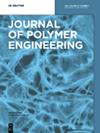通过调控SiO2杀菌剂的表面富集来提高聚氨酯共混膜的抗菌活性
IF 1.7
4区 工程技术
Q4 POLYMER SCIENCE
引用次数: 0
摘要
摘要聚氨酯(PU)与纳米杀菌剂共混是获得具有抗菌性能的PU的主要途径之一。然而,纳米杀菌剂不能有效地富集PU表面,降低其抗菌性能。在本研究中,含有大量极性季铵盐(N, N -二甲基-3-氨基丙基-12-烷基-溴化铵三甲基硅基,简称QAC)的纳米二氧化硅颗粒与PU膜共混后,很容易富集PU表面,使PU具有优异的抗菌性能。不同直径二氧化硅表面的QAC(记为sio2 - q - X)可以赋予二氧化硅抗菌性能,并改善二氧化硅与PU之间的斥力,从而增强二氧化硅在PU表面的富集。制备了一系列sio2 - q - X /PU共混膜,并应用于抑制细菌菌落的生长。sio2 - q - X /PU膜能抑制革兰氏阴性大肠杆菌和革兰氏阳性表皮葡萄球菌的生长。极性QAC较多的sio2 - q - X易于在PU表面富集,杀菌效果优于极性QAC较少的sio2 - q - X。此外,sio2 - q - X /PU薄膜的老化不影响其抗菌效果。本文章由计算机程序翻译,如有差异,请以英文原文为准。
Promoting antibacterial activity of polyurethane blend films by regulating surface-enrichment of SiO2 bactericidal agent
Abstract Polyurethane (PU) blended with nano-bactericidal agents was one of the most ways to obtain PU with antimicrobial properties. However, the bactericidal agent nanoparticles cannot effectively enrich the PU surface to reduce their antimicrobial properties. In this study, nano-silica particles with a large number of polar quaternary ammonium salt ( N , N -dimethyl-3-aminopropyl-12-alkyl-ammonium bromide trimethylsilyl, denoted as QAC) can easily enrich the PU surface to endow PU with excellent antibacterial properties after they were blended with PU film. The QAC on the surface of silica with different diameters (denoted as SiO 2 -Q- X ) can endow silica with antimicrobial properties and improve the repulsion between silica and PU to enhance the enrichment on PU surface of silica. A series of SiO 2 -Q- X /PU blend films were prepared and applied to inhibit the growth of the bacterial colony. The SiO 2 -Q- X /PU films can inhibit the growth of Gram-negative Escherichia coli and Gram-positive Staphylococcus epidermidis . The SiO 2 -Q- X with more polar QAC was easily enriched on the surface of PU and had a better bactericidal effect than those of SiO 2 -Q- X with a minor polar QAC. Moreover, the aging of the SiO 2 -Q- X /PU films did not affect their antibacterial effect.
求助全文
通过发布文献求助,成功后即可免费获取论文全文。
去求助
来源期刊

Journal of Polymer Engineering
工程技术-高分子科学
CiteScore
3.20
自引率
5.00%
发文量
95
审稿时长
2.5 months
期刊介绍:
Journal of Polymer Engineering publishes reviews, original basic and applied research contributions as well as recent technological developments in polymer engineering. Polymer engineering is a strongly interdisciplinary field and papers published by the journal may span areas such as polymer physics, polymer processing and engineering of polymer-based materials and their applications. The editors and the publisher are committed to high quality standards and rapid handling of the peer review and publication processes.
 求助内容:
求助内容: 应助结果提醒方式:
应助结果提醒方式:


